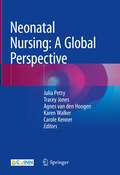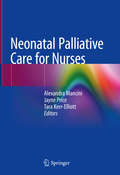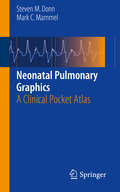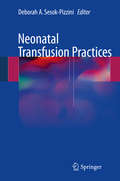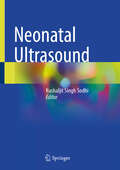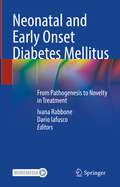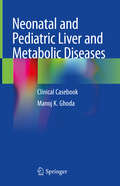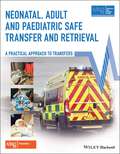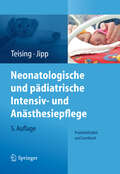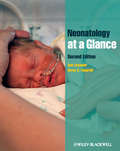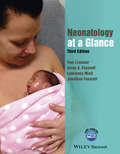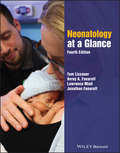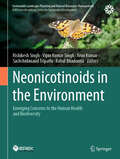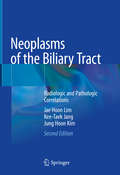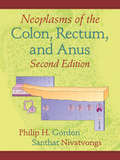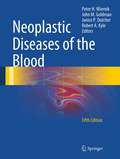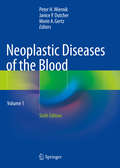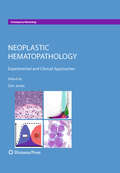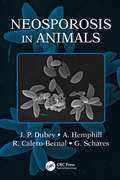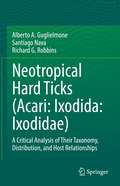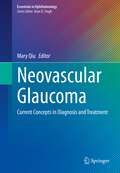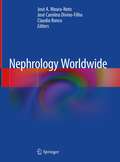- Table View
- List View
Neonatal Neural Rescue: A Clinical Guide
by Joseph J. Volpe A. David Edwards Denis V. Azzopardi Alistair J. GunnWorldwide more than one million babies die annually from perinatal asphyxia and its associated complications such as neonatal encephalopathy - one of the major causes of cerebral palsy and cognitive deficiencies in children aside from prematurity. Cooling the head - or the entire body - minimizes neuronal death, enabling the neonatal brain to be 'rescued' thus greatly improving developmental outcomes. Hypothermic neural rescue therapy has revolutionized the treatment of this condition and is a major recent achievement in neonatal medicine. This landmark book provides a brief scientific underpinning of hypothermic neural rescue therapy and lays out the evidence base for good practice. Internationally recognized authorities give practical advice, drawn from personal experience, on how to deliver hypothermia in the neonatal intensive care unit. A valuable addition to any neonatal unit, this is essential reading for neonatologists, neonatal nurses and paediatric neurologists.
Neonatal Nursing: A Global Perspective
by Julia Petty Tracey Jones Agnes van den Hoogen Karen Walker Carole KennerThis textbook is written in line with the Council of International Neonatal Nurses, Inc. (COINN) vision for global unity for neonatal nursing. The core values and goals of COINN are based on excellence and advocacy for high quality newborn care, as well as respecting diversity by integrating cultural norms and values among the care of newborns and their families. The book promotes neonatal nursing as a global speciality through evidence, research, and education of neonatal nurses; and offers key examples of the millennium goals and global outcomes, as well as variations in outcomes for babies.The first part focuses on global perspectives of neonatal nursing from different continents aligning with the World Health Organizations’ global regions: (The Americas -USA, Canada and South America-, Western Pacific region -Australia and New Zealand-, European region -UK and Europe-, African region, South-East Asia and Eastern Mediterranean region. For each region, education and competencies, challenges and opportunities, research and evidence-based practice (EBP) as well as practice regulations are described. The second part elaborates on key topics for neonatal nursing across the globe, such as the continuity of neonatal care in the community, patient and family centered care in neonatal settings, sleep and brain development, the fundamental care needs of the neonate and family and global perspectives on hypothermia, hypoglycaemia and hypoxia. Written in a formal academic but reader style, using key literature and evidence, this textbook enables an understanding from a large audience with academic levels and experience, both staff and students, bedside nurses, advanced practice nurses, midwifes and allied professionals. In addition, first person story based reflective narrative are interspersed throughout the book to capture the perspectives of nurses, staff and parents, in the form of vignettes. This textbook is aimed at neonatal nurses across the world as well as current and aspiring students in this field.
Neonatal Pain
by Giuseppe Buonocore Carlo Valerio BellieniThis completely revised and updated edition offers a comprehensive overview of neonatal pain assessment and treatment. It includes the field of fetal surgery, and many other topics have been updated or added, such as circumcision analgesia, new drugs, new insights into neurophysiologic pathways of neonatal pain and new drawbacks of analgesic drugs. While in the early years of the 21st century pain treatment in neonates was still optional, it is now a tenet, and more and more institutions are looking for inspiration and good references to create their own guidelines. Written by leading researchers in the field, this book provides that inspiration and offers a valuable tool for neonatologists, anesthetists, nurses and physiotherapists. Since it also deals with prenatal and postnatal surgery, it also appeals to surgeons.
Neonatal Palliative Care for Nurses
by Jayne Price Alexandra Mancini Tara Kerr-ElliottThis textbook details the nursing care of babies with life limiting conditions and sets the context within the philosophy of internationally collaborative neonatal palliative care emphasising emotional and practical support for their families. Currently, increasing interest from nursing and medical fields regarding palliative care for babies in the antenatal and neonatal period is evident.This innovative and unique text provides experienced nurses and student nurses alike with realistic guidance in caring for babies with palliative care needs, alongside the crucial support for their families and identifies important strategies for professional self care. Nursing experts in this field collaborated to develop a reference book which supports holistic and integrated clinical practice. Parents’ experiences of what they consider helpful or not so helpful are interwoven throughout the chapter.There is currently no other textbook which offers the above information and guidance specifically for nurses and allied health professionals. As such this book will appeal to all nurses and health professionals working within the neonatal palliative care specialty in a global context.
Neonatal Pulmonary Graphics
by Steven M. Donn Mark C. MammelThis pocket atlas explains how to use pulmonary graphics as a valuable adjunct for patient management. Actual patterns commonly encountered in neonatal practice are presented side-by-side with schematic illustrations that take apart the graphic and identify its key features, accompanied by brief explanatory text. The book addresses the principles of real-time pulmonary graphics, discusses waveforms and loops, and examines how both are affected by mechanical ventilation and disease states. A series of clinical cases brings key points to life.
Neonatal Transfusion Practices
by Deborah A. Sesok-PizziniThis book provides a concise yet comprehensive review of neonatal transfusion medicine. The text covers major areas of the field, including chapters dedicated to pre transfusion testing, manufacturing, standards and stora≥ blood product administration; special congenital and acquired disorders in the neonate; hemolytic disease of the newborn; intrauterine transfusions; adverse reactions; and ECMO. The volume features contributions from a diverse group of experts in the field and include pathologists, anesthesiologists, neonatologists, a pediatric hematologist and oncologist, and a high-risk obstetrician. These authors contribute their unique expertise and perspectives to the practice of neonatal transfusion medicine and allow the reader to experience an in depth introduction to each of the chapter topics. Neonatal Transfusion Practices is a valuable, go-to reference that addresses some of the more frequent questions asked by clinicians and professionals who have limited exposure to neonatal transfusion practices.
Neonatal Ultrasound
by Kushaljit Singh SodhiThe book covers all aspects of neonatal ultrasound including advances in imaging technology. It covers the technique, clinical applications and recent advances of ultrasound in neonates. Chapters provide easy and systematic approach to the diagnosis of various pathological entities in neonates and includes infections, inflammation, and tumors. Chapters are divided based on organ wise distribution which helps the readers in easy understanding and practical applications. The book also includes the important normal variants and anatomical landmarks based on ultrasound. It provides key points in each chapter. It is written by national and international experts. The book helps practicing consultants and residents in early and rapid diagnosis of various conditions from head to toe in neonatal ultrasound.
Neonatal and Early Onset Diabetes Mellitus: From Pathogenesis to Novelty in Treatment
by Ivana Rabbone Dario IafuscoThis comprehensive volume collects contributions by leading experts on neonatal diabetes. It provides the reader with the most up-to-date information about all the progresses that have been made and that have led to the clarification of the pathogenesis of all the forms of diabetes. From pathogenesis to novelty in therapy, the book will cover all aspects of the diagnosis and treatment also discussing rare forms of early onset diabetes, insulin therapy, pump therapy and technologies, acute and chronic complications. The volume is enhanced by videos showing the impact of treatments on movement difficulties, psychomotor development, and muscle tone. Slide decks with key messages are also available for download and usage during congresses and lessons. This book will be of benefit to pediatricians, endocrinologists, neonatologists and all physicians who deal with neonates affected by this disease
Neonatal and Pediatric Liver and Metabolic Diseases: Clinical Casebook
by Manoj K. GhodaThis book is written to simplify complex topics of neonatal and pediatric liver and metabolic diseases which are encountered by clinicians on a day to day basis. Neonatal and early pediatric liver diseases are very much different from adult liver diseases. Most of them are either structural diseases or genetically modulated metabolic disorders affecting liver. They all look same; however the underlying etiology could be quite different. This book thoroughly covers various neonatal and pediatric liver and metabolic diseases through a unique clinical case based approach via a vast clinical experience of the author. The book presents more than 50 unique cases and presents real life learning scenario with various examples facilitating better understanding of the disease and the ways to analyze it. The book uses a simple language and presents line diagrams and algorithms facilitating learning. This book shall be a valuable resource for practicing general pediatricians, pediatric residents and gastroenterologists with involvement in pediatric liver and liver related metabolic diseases.
Neonatal, Adult and Paediatric Safe Transfer and Retrieval: A Practical Approach to Transfers (Advanced Life Support Group)
by Advanced Life Support Group (ALSG)Neonatal, Adult and Paediatric Safe Transfer and Retrieval is a new and vital instalment in the blended learning course from the Advanced Life Support Group (ALSG), which aims to provide hospital staff at all levels with essential information on the inter- and intra-hospital transfer of both child and adult patients. This essential manual covers the basics of mobile medicine, the elements of transfer, patient and team safety, and the practical and clinical considerations associated with the patient transfer process. Each chapter makes use of checklists, practical examples and content summaries to help readers understand and overcome the challenges of both adult and paediatric patient transfers. Combines Paediatric and Neonatal Safe Transport and Retrieval (PaNSTaR) and the (Adult) Safe Transport and Retrieval (STaR) into a single volume (NAPSTaR) Written and edited by an expert team of specialists from across the UK Complements Advanced Paediatric Life Support and Prehospital Paediatric Life Support Neonatal, Adult and Paediatric Safe Transfer and Retrieval is a must-have resource for doctors, nurses, paramedics and healthcare professionals involved in patient transfer and those in ALSG courses in patient transport.
Neonatologische und pädiatrische Intensiv- und Anästhesiepflege
by Dagmar Teising Heike Jipp Hannah Tönsfeuerborn Nadja KrauseDiese Buch richtet sich an Pflegende auf Neugeborenen- und Kinderintensivstationen sowie in der Anästhesie und bietet alle relevanten Inhalte der Fachweiterbildung und umfangreiches Wissen für die tägliche Arbeit mit den Patienten.Die Durchführung von allgemeinen und speziellen Pflegemaßnahmen in der neonatologischen und pädiatrischen Intensivpflege erfordert besondere fachliche und psychosoziale Fähigkeiten. Meistern Sie diese Herausforderung und lernen Sie von den erfahrenen Autorinnen alle wesentlichen Aspekte für die Praxis. Übersichtliche Checklisten ermöglichen Ihnen einen schnellen Zugang zu den wichtigen Informationen und erleichtern den Einstieg in diesen anspruchsvollen Aufgabenbereich.
Neonatologische und pädiatrische Intensiv- und Anästhesiepflege: Praxisleitfaden und Lernbuch
by Dagmar Teising Heike JippDie Anästhesie- und Intensivpflege der kleinsten und kleinen Patienten erfordert eine hohe Kompetenz und Verantwortung. In dem Praxisleitfaden vermitteln die Autorinnen das Fachwissen für pädiatrische und neonatologische Intensivstationen sowie für die Anästhesiepflege und erläutern die Pflegetechniken kurz und präzise. Arbeitshilfen wie Fragen für die Wissensüberprüfung, Checklisten und Tipps für die Elternberatung machen das Buch zum Alltagsbegleiter. Die 5. Auflage wurde an alle neuen relevanten Richtlinien angepasst und durch neue Medikamente sowie das Kapitel „Hirntod und Transplantation“ ergänzt.
Neonatology at a Glance
by Tom Lissauer Avroy A. FanaroffThe at a Glance series is popular among medical students, residents, junior doctors and health professionals for its concise and clear approach and excellent illustrations. Each topic is concisely covered in a double-page spread with color summary diagrams accompanied by explanatory text. Covering a wide range of topics, books in the at a Glance series are ideal as introductory subject texts or for revision purposes, and are useful throughout medical and nursing training and beyond. Everything you need to know about Neonatology. . . at a Glance! Written by leading international experts, this accessible overview provides need-to-know information on perinatal medicine, the normal newborn infant, preterm infants and neonatal problems encountered in Intensive Care Units, and their management. Neonatology at a Glance: Provides coverage of the important conditions you will encounter Addresses ethical issues, the death of an infant, quality assurance and evidence-based medicine Includes invaluable advice on practical procedures, in text and diagrammatic form Has been updated to reflect current practice in both the UK and US Neonatology at a Glance is the perfect guide for all health professionals looking after newborn infants, including paediatric trainees, medical students, neonatal nurse practitioners and neonatal nurses, therapists and midwives. For neonatologists, pediatricians and nurse tutors it is a valuable resource to assist with teaching.
Neonatology at a Glance
by Lawrence Miall Tom Lissauer Avroy A. Fanaroff Jonathan FanaroffNeonatology at a Glance provides a concise, illustrated overview of neonatal medicine. Written by leading international experts, it provides essential information on perinatal medicine, delivery, the normal newborn infant and neonatal problems encountered in neonatal intensive care units and their management. Each topic is supported by excellent illustrations, diagrams, and, for the first time, video clips to show neonatal resuscitation and stabilizing the sick newborn, normal examination, the baby with hypoxic-ischemic encephalopathy, recognition of seizures and practical procedures. Neonatology at a Glance: * Provides up to date coverage of the important conditions you will encounter * Covers challenging topics including pain, ethical issues, quality improvement, evidence based medicine and palliative care * Features new sections on fetal medicine, respiratory support, therapeutic hypothermia, amplified EEG and perinatal neuroimaging * Integrates invaluable details about practical procedures including neonatal resuscitation and transport * Supplemented by video materials and artwork which can be viewed via the companion website at www.ataglanceseries.com/neonatology Neonatology at a Glance is the perfect guide for all health professionals looking after newborn infants, including pediatric trainees, medical students, neonatal nurse practitioners and neonatal nurses, therapists and midwives. For neonatologists, pediatricians and nurse tutors it is a valuable resource to assist with teaching.
Neonatology at a Glance (At a Glance)
by Tom LissauerWritten by a team of leading international experts, Neonatology at a Glance provides a concise and easy-to-read overview of neonatal medicine. Each topic is clearly explained over a two-page spread, aided by numerous diagrams and illustrations. It has been extensively updated to include recent advances in perinatal medicine, genetics, respiratory support, therapeutic hypothermia, antimicrobial stewardship, and family integrated care. The book covers the wide range of problems encountered in looking after newborn babies, from normal newborn infants to the complexities of neonatal intensive care. Neonatology at a Glance: Provides up-to-date coverage of the important conditions you will encounter, including neonatal resuscitation and care of preterm infants Covers challenging topics including pain, ethical issues, patient safety, evidence-based medicine, and palliative and end of life care Includes details of a wide range of practical procedures, including less invasive surfactant administration, cranial ultrasound, brain monitoring and neuroimaging, and neonatal transport Neonatology at a Glance is the perfect guide for all health professionals looking after newborn infants, including pediatric trainees, medical students, neonatal nurse practitioners and neonatal nurses, therapists, and midwives. For neonatologists, pediatricians, and neonatal lecturers, it is a valuable resource to assist with teaching.
Neonicotinoids in the Environment: Emerging Concerns to the Human Health and Biodiversity (Sustainable Landscape Planning and Natural Resources Management)
by Arun Kumar Rishikesh Singh Rahul Bhadouria Vipin Kumar Singh Sachchidanand TripathiThe proposed book presents the current state of knowledge about the processes, parameters, and phenomena that influence the fate of neonicotinoids in soil-water systems (i.e., soil and groundwater), as well as their effects and mitigation measures, and identifies existing knowledge gaps. Furthermore, groundwater/surface water interactions, as well as sorption, biodegradation, and chemical transformations of neonicotinoids in the soil and leaching to the groundwater, are highlighted, as they determine their further migration from sources, through soils to groundwater systems, and then to other environmental compartments, posing ecological and human risks. The ecological risks of neonicotinoids are highlighted in a separate section with special emphasis on the impacts on biological diversity.
Neoplasms of the Biliary Tract: Radiologic and Pathologic Correlations
by Jung Hoon Kim Jae Hoon Lim Kee-Taek JangThis book provides a thorough overview of the radiologic and pathologic findings of neoplastic diseases of the biliary tract, a sound knowledge of which is essential for appropriate patient management. A key feature is the correlation of imaging findings with both gross pathologic and histopathologic findings for each disease. This is of the utmost importance in understanding true pathologic abnormalities, bearing in mind, for example, the difficulty in ascertaining disease spread and extent on the basis of pathology alone. Since the first edition of the book, conceptual understanding of neoplastic disease of the bile ducts and cholangiocarcinogenesis has evolved significantly, and in the new edition the classification of diseases is based on the most recent edition of the WHO Classification of Tumors of the Digestive System. In addition, some newly recognized pathologies are covered. The book will enhance understanding of the pathology of neoplastic diseases of the biliary tract and aid imaging interpretation. It will be a great asset for pathologists, radiologists, biliary surgeons, and gastroenterologists.
Neoplasms of the Colon, Rectum, and Anus
by Philip H. Gordon Santhat NivatvongsColorectal cancer is the second-leading cause of cancer-related death in the Western World. This Second Edition analyzes the genetics, mechanisms, and development of colorectal carcinoma and supplies the latest research and recommendations on the detection, treatment, and prevention of malignancies of the colon, rectum, and anus.
Neoplastic Diseases of the Blood
by Peter H. Wiernik Janice Dutcher Robert A. Kyle John M. GoldmanNeoplastic Diseases of the Blood integrates the history, epidemiology, pathology, pathophysiology, and therapeutics of modern neoplastic hematopathology. The book is divided into five major sections, with the first four covering the spectrum of hematologic neoplasia-- Chronic Leukemias and Related Disorders , Acute Leukemias, Myeloma and Related Disorders, and Lymphomas. The fifth section covers a variety of topics in supportive care. Now in its fifth edition, this classic and invaluable text brings together a team of internationally renowned experts and offers in-depth coverage of the complex interface between diagnosis and therapy. Chapters feature an accessible and easy-to-read layout and provide updates on the tremendous progress made in the last decade in the understanding of the nature of hematologic malignancies and their treatment. An authoritative and indispensable resource for students, trainees, and clinicians, this fifth edition is sure to distinguish itself as the definitive reference on this topic.
Neoplastic Diseases of the Blood
by Peter H. Wiernik Morie A. Gertz Janice P. DutcherThe new edition of this textbook integrates the history, epidemiology, pathology, pathophysiology, therapeutics, and supportive care of modern neoplastic hematopathology. Now in its sixth edition, this classic and invaluable text brings together a team of internationally renowned experts and offers in-depth coverage of the complex interface between diagnosis and therapy. The textbook is divided into five major sections, with the first four covering the spectrum of hematologic neoplasia, including chronic leukemias and related disorders, acute leukemias, myeloma and related disorders, and lymphomas, and the fifth section covering a variety of topics in supportive care. Chapters are presented in an accessible and easy-to-read layout, providing updates on the tremendous progress made in the last decade in the understanding of the nature of hematologic malignancies and their treatment.Neoplastic Diseases of the Blood, Sixth Edition is an authoritative and indispensable resource for students, trainees, and clinicians, sure to distinguish itself as the definitive reference on this subject.
Neoplastic Hematopathology
by Dan JonesFulfilling the void with a Hematopathology book that integrates clinical and experimental studies with diagnostic criteria, Neoplastic Hematopathology: Experimental and Clinical Approaches provides an overview of the discipline of hematopathology that connects the field with recent advances in immunology research and current clinical practice in the treatment of lymphomas and leukemias. Designed for both trainees and specialists in pathology and hematology-oncology, Neoplastic Hematopathology: Experimental and Clinical Approaches has separate sections on laboratory techniques, diagnostic hematopathology, treatment and stem cell transplantation. Expert chapter authors address both myeloid and lymphoid tumors, and provide much needed coverage in transplant biology. A study guide highlights key chapter points, making the text suitable for boards review in hematopathology and hematology-oncology.
Neosporosis in Animals
by R. Calero-Bernal J.P. Dubey A. Hemphill Gereon ScharesKey features: Written by the scientist who named this parasite and was the first to set up proper diagnostic techniques Serves as the first ever book to provide information on the parasite structure, biology, pathogenesis, clinical signs, epidemiology, prevention, and control of neosporosis Covers both approaches toward preventing & controlling this disease: Developing an efficacious vaccine and sound cattle management practices Contains a wealth of illustrations, including many of the author's original photographs of the parasite Provides basic information on immunologic and molecular aspects of the disease Abortion is a worldwide problem in the livestock industry accounting for annual economic losses of billions of dollars, and N. caninum is a major cause of it. Neosporosis is a newly recognized disease of animals. Until 1988 it was misdiagnosed as toxoplasmosis. Considerable progress in understanding the biology of neosporosis has been made in the last 30 years, resulting in more than 2,000 scientific publications. The economic importance of abortion in cattle, and the availability of knowledge, reagents, and technology used to study toxoplasmosis, have contributed to the rapid progress in understanding the biology of neosporosis. Written by pioneers in this field, Neosporosis in Animals presents a comprehensive summary of the biology of neosporosis, starting with chapter 1 on the historical background of the discovery of the disease. Subsequent chapters deal with general aspects of the biology of N. caninum (chapter 2), techniques (chapter 3), and the disease caused by this parasite in cattle (chapter 4), dogs (chapter 5), and all other animals including sheep, pigs, primates and humans (chapters 6-18). This book provides, for the first time in a single authoritative source, a complete account of the structure, biology, clinical disease, diagnosis, epidemiology, treatment, attempts at immunoprophylaxis, and control in all hosts. There are 175 illustrations and tables devoted to the life cycle, structure of parasitic stages, and lesions. More than 2100 references are cited, allowing the reader to locate additional information on specific topics in an efficient way. This book will be useful to a broad range of researchers in biology and veterinarians.
Neotropical Hard Ticks (Acari (Acari (Acari (Acari: Ixodida: Ixodidae): A Critical Analysis of Their Taxonomy, Distribution, and Host Relationships
by Alberto A. Guglielmone Richard G. Robbins Santiago NavaOf the 758 species of hard ticks (family Ixodidae) currently known to science, 137 (18%) are found in the Neotropical Zoogeographic Region, an area that extends from the eastern and western flanks of the Mexican Plateau southward to southern Argentina and Chile and that also includes the Greater and Lesser Antilles and the Galápagos Islands. This vast and biotically rich region has long attracted natural scientists, with the result that the literature on Neotropical ticks, which are second only to mosquitoes as vectors of human disease and are of paramount veterinary importance, is enormous, diffuse, and often inaccessible to non-specialists. In this book, three leading authorities on the Ixodidae have combined their talents to produce a summary of essential information for every Neotropical tick species. Under each species name, readers will find an account of the original taxonomic description and subsequent redescriptions, followed by an overview of its geographic distribution and host relationships, including a discussion of human parasitism. Additional sections provide detailed analyses of tick distribution by country and zoogeographic subregion (the Caribbean, southern Mexico and Central America, South America, and the Galápagos Islands), together with a review of the phenomenon of invasive tick species and examination of the many valid and invalid names that have appeared in the Neotropical tick literature. The text concludes with an unprecedented tabulation of all known hosts of Neotropical Ixodidae, including the tick life history stages collected from each host. This book is an invaluable reference for biologists and biomedical personnel seeking to familiarize themselves with the Neotropical tick fauna.
Neovascular Glaucoma: Current Concepts in Diagnosis and Treatment (Essentials in Ophthalmology)
by Mary QiuThis book offers a comprehensive overview of neovascular glaucoma (NVG), which is an extraordinarily aggressive type of secondary glaucoma that has often been discussed as an afterthought rather than the focal subject in glaucoma reference books. NVG is considered an end stage complication in patients with certain underlying retinal diseases, most commonly diabetic retinopathy and retinal vein occlusions. Historically, NVG has been one of the most difficult types of glaucoma to manage, with a high failure rate for traditional glaucoma surgery, and often progression of the underlying retinal disease despite “standard of care” treatment. Chapters cover advancements made in recent years in the management of the underlying ischemic retinal conditions that lead to NVG, including the use of anti-vascular endothelial growth factor (anti-VEGF) medications. Additionally, chapters discuss glaucoma surgeries, which have become less invasive in recent years with the advent of microinvasive glaucoma surgery (MIGS). This book offers an up-to-date reference regarding current concepts in the diagnosis, as well as medical, laser, and surgical treatment of NVG in the anti-VEGF era, with attention to the close collaboration between glaucoma specialists and retina specialists. Neovascular Glaucoma - Current Concepts in Diagnosis and Treatment will change the way ophthalmologists manage NVG, ensuring patients better outcomes. It is a must-have resource for ophthalmologists worldwide.
Nephrology Worldwide
by Claudio Ronco José A. Moura-Neto José Carolino Divino-FilhoThis book presents contributions from leading international experts in the field of nephrology. Each chapter is independent and discusses nephrology in the author’s country, including the history of nephrology development, kidney disease epidemiology, clinical nephrology, dialysis practice in acute and chronic renal failure settings (hemodialysis, hemodiafiltration, peritoneal dialysis), pediatric nephrology, and kidney transplantation. In addition, the book covers topics such as the job market for nephrologists, reimbursement, nephrology education, and the number of professionals in the private and public sectors. With 53 chapters and more than 300 authors from all continents offering a unique perspective on nephrology practice, it provides a much-needed information source for nephrologists around the globe. The reader will be able to travel through “Nephrology Worldwide”, a pleasant reading experience with not only relevant information and updated data, but also a comprehensive look at the history, countries’ peculiarities, and a critical analysis of the scenario of nephrology and renal replacement therapy. A valuable resource for healthcare professionals and other stakeholders interested in learning about the status quo of Nephrology Worldwide. “Both the failings and the successes are outlined in a way that should make this book a compelling read, not just for the well-informed renal physician, but also for planners and policy makers whose thinking and actions are integral to the way we practice medicine.” - Sir Peter J. Ratcliffe, Nephrologist and 2019 Nobel Prize WinnerMore information on the Nephrology Worldwide initiative can be found at www.nephrologyworldwide.com.

